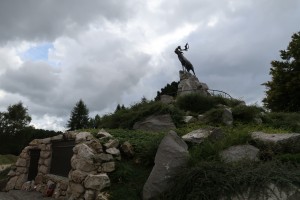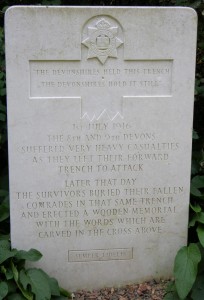
Beaumont-Hamel Newfoundland Memorial.
(P. Ferguson image, September 2017)
Remembrance on the Somme
A visit to the Commonwealth War Graves website begins Close to 150,000 Commonwealth casualties are buried in close to 350 sites on the Somme. They range from large cemeteries with thousands of graves to individual graves in churchyards and burial grounds.
There are eight memorials to the missing of the Battle of the Somme including Beaumont-Hamel. I have visited Beaumont-Hamel at times but on this one occasion in 2017 more poignant knowing I came to fulfill a family request to picture from one panel – two names who remain somewhere in France.
This was the most recent visit but an earlier visit in 2006 was equally poignant as I heard from one fellow interested in the Devonshire Regiment and their thoughtful encounter with this place of memory…the Devonshire Cemetery..and its memorial tablet…

Devonshire Cemetery Tablet, Somme, France.
(P. Ferguson image, September 2006)
The Inscription
The Devonshires Held This Trench
The Devonshires Hold It Still
1st July 1916
The 8th and 9th Devons
Suffered Very Heavy Casualties
As They Left Their Forward
Trench to Attack
Later That Day
The Survivors Buried Their Fallen
Comrades In That Same Trench
And Erected A Wooden Memorial
With The Words Which Are
Carved In The Cross Above
Semper Fidelis
Tags: Beaumont-Hamel (Newfoundland) Memorial, Devonshire Cemetery, Devonshire Cemetery Tablet, Inscriptions, Somme 1916
This entry was posted by pferguson
on Sunday, July 30th, 2023 at 8:41 pm and is filed under Remember Them Well, Snapshots of the Great War.
You can follow any responses to this entry through the RSS 2.0 feed.
You can leave a response, or trackback from your own site.
About The Author

Paul has worked with the Paradigm Motion Picture Company since 2009 as producer, historian and research specialist. Paul first met Casey and Ian WIlliams of Paradigm in April 2007 at Ieper (Ypres), Belgium when ceremonies were being held for the re-dedication of the Vimy Memorial, France.
Paul's sensitivity to film was developed at an early age seeing his first films at RCAF Zweibrucken, Germany and Sardinia. Paul returned to Canada in 1967 and was captivated by David Lean's "Lawrence of Arabia" and "Bridge on the River Kwai". Over time Paul became increasingly interested in storytelling, content development, character, direction, cinematography, narration and soundtracks.
At the University of Victoria, Paul studied and compared Japanese and Australian film and became interested in Australian film maker Peter Weir and his film "Gallipoli" (1981). Paul was inspired when he learned Weir visited the beaches, ridges and ravines of the peninsula. "Gallipoli", the film, led Paul on many journeys to sites of conflict in England, France, Belgium, Holland, Germany, Malta, Hawaii, Gallipoli, North Macedonia and Salonika.
When Paul first watched documentary filmmaker Ken Burns, "The Civil War", Paul understood how his own experience and insight could be effective and perhaps influential in film-making. Combining his knowledge of Museums and Archives, exhibitions and idea strategies with his film interests was a natural progression.
Paul thinks like a film-maker. His passion for history and storytelling brings to Paradigm an eye (and ear) to the keen and sensitive interests of; content development, the understanding of successful and relational use of collections, imagery and voice. Like Paul's favorite actor, Peter O'Toole, Paul believes in the adage “To deepen not broaden.”
While on this path Paul always remembers his grandmother whose father did not return from the Great War and how his loss shaped her life and how her experience continues to guide him.



Comments